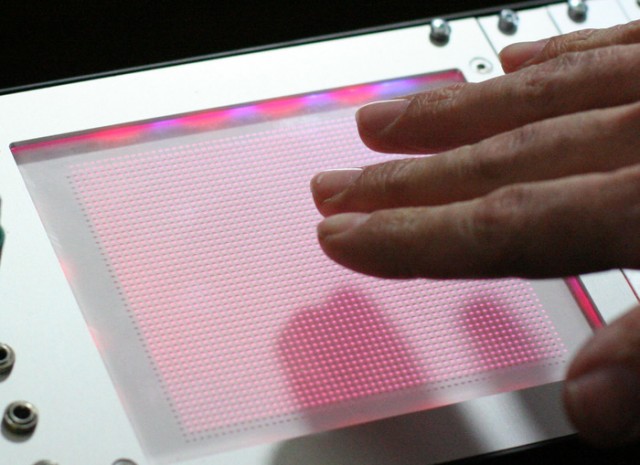Developer Matt Heins has announced the Hackme Vector – a new way to interact with a modular synthesizer that’s a bit like a theremin on steroids.
Vector is a three dimensional control interface designed for Eurorack modular system. It senses the location of a hand over its face and outputs a signal proportional to position for each axis: x (left and right), y (up and down), and z (in and out).
Vector works by generating an electrical field and sensing changes in it causes by the proximity of your hand. Think of it as a smartphone screen with an added dimension of depth four to five inches from the surface. The system uses six electrodes to form the active sensing area. The sensing electrodes are part of the circuit board which lays just behind the piece of acrylic.
This allows you to control three things at one time, like turning three knobs all at once by moving your hand through the air. You could control the amplitude of a sound with the x axis, the pitch with the y axis, and the modulation of that sound with the z axis.
Here’s the official video into for the project:
LED Feedback
To provide feedback, Vector has LEDs ringing its active sensing area. These LEDs light up according to the location of your hand.
Vector lights red for the z axis and blue for the x and y axis. As you get closer to the surface, the red LEDs get brighter. As you move closer to a location on the x-y axis, the blue LEDs in that region get brighter and those farther away get dimmer.
Gesture Recognition
Vector can also recognize a number of simple gestures. It recognizes swiping gestures, as well as circular motions over its surface. These gestures can be used as trigger outputs and for interacting with the built-in looping feature. Vector provides a menu system that uses gestures to change the system behavior.
Looping
Vector can record up to 30 seconds of position and gesture data for looping playback. Simply press the large illuminated switch to start the loop and release it to end it. The loop plays back immediately.
The loop can be retriggered with swipe gestures or by external signals from a module with trigger outputs. Vector records as long as the switch is held down, so long rhythmic sequences can be recorded by moving a hand in an out of the active area.
The loop switch can also be used as a sample and hold control. When pressed quickly, it freezes the hand position to lock in the output. The loop playback can be sped up or slowed by using circular gestures, clockwise for faster, counter-clockwise for slower. The loop recording can also be triggered externally. One pulse starts the recording and the next pulse ends it. Using external triggers to start and stop recording as well as to synchronize the playback, you can make perfectly synchronized loops.
Vector is being developed as a Kickstarter project, with the controller available to early supporters for $299. See the project site for details.


Patent pending, so no-one else can make anything similar. Boo.
Looks very interesting, but looks like it would take up a whole skiff! Would like to see some better demos as well
Judy Jetson had one of these years ago.
I agree with Aidan that this video demo is limited. Surely if you’ve got three CV outputs in continuous variance you can be more imaginative? If I heard it doing, say, LFO rate, filter mod depth and some kind of hard sync thing between VCOs it would be more convincing — but why stop there? There are thousands of possibilities. However, it looks like a really good idea.
I’m always very leery of supporting tech Kickstarters. While this modules looks very interesting and quite promising, I would definitely have to wait for the actual product to be completed and visible to the public (post-Kickstarter in this case) before I’d be able to throw $300 at it.
Also, it seems to be like it would be kind of a problem with manipulating the electrical filed in the module when you don’t want to; anytime your hand passes over it you will be sending out CV signals, intentionally or not. If you’ve got this module next to other modules in a tight and cramped eurorack system this seems like it could be a very real problem. Because of this I would almost rather have a touchpad module, or a stand-alone version of this 3D module that can be off to the side of my system.
I wish Roland would release their “D Beam” into the public domain.
It could do with some enhancements and it had limited resolution )stepping) if I’m not mistaken.
The resolution was pretty awful, but it also wasn’t as versatile as you might think. In real performative scenarios it really had very few uses beyond triggering novelty chime sounds and stuff.
It wasn’t limited linked to ableton.